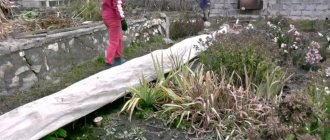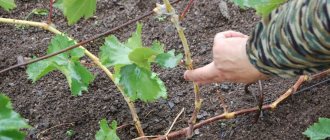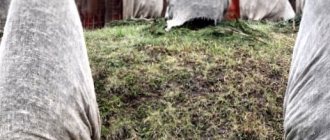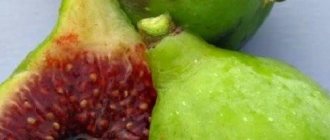When should grapes be covered?
Grape roots can freeze at temperatures below -5 °C, so all work is carried out before this point. If the root system freezes, the entire bush will die. When the above-ground part freezes, the grapes can be restored.
There are varieties that can withstand frost down to -28 °C, but even they can freeze at a temperature of -20 °C. If the temperature is predicted to drop to at least -4...-5 °C, frost-resistant grapes need to be insulated.
Why is it important to strictly observe the timing of covering grapes for the winter:
- if insulation is done too early, there is a risk of the plant rotting, becoming moldy, creating condensation, which causes the crop to die;
- if you are late with insulation, the roots will freeze.
Measures to cover the bush are carried out only in dry weather - there should be no traces of high humidity on the soil and plant.
The main condition is that the vine is hardened, i.e., it is given the opportunity to endure the first frosts while open. This rule applies exclusively to adult crops.
When the grapes open
Grapes after winter
Another important event in the series of grape care activities is their opening in the spring. Here, too, you need to meet all deadlines. If you remove the protection too early, spring frosts can damage the kidneys. For this, -3 C will be enough. Then the vine will have to grow replacement buds instead of dead ones. Not all grape varieties bear fruit on shoots developing from such buds. Even if the harvest ripens, it will be much less than usual.
You shouldn’t delay opening too much. Warm weather will play a cruel joke on covered grapes. Under protection, a greenhouse effect is created, expressed in increased temperature and humidity. This threatens fungal diseases and various infections.
To find the golden mean and open the grapes in time, we monitor the thermometer readings. Average daily temperature is 10 C? No frost promised? Are buds swelling on bushes and trees? It's time to get to work. In the Moscow region, this period usually falls in May.
Choosing timing based on geographic location
The time of warming depends on the regional growth of the crop:
- Moscow region and Leningrad region. The average daily air temperature should be no more than -2 °C, so the work process is carried out after November 20 and before December 10. Preparations should begin in late September.
- Ural and Western Siberia. Preparatory activities are carried out from late August to early September. Shelter period is from October to early November.
- Central Russia. The vine takes shelter 20-30 days after the leaves completely fall off, i.e. in mid-November.
- Ukraine. These are relatively warm regions, where the timing of grape warming shifts towards winter, especially with the late onset of “Indian summer”. The optimal period is November, in the south of Ukraine – December.
Choosing the right time
When answering the question of when to cover a plant for the winter, it is difficult to name a specific date, but mid-October is considered the most favorable choice. For successful wintering, grapes need to be provided with “air-dry” shelter. Wait for a dry day, check that no parts of the plant are wet, and begin covering. For these purposes, following simple rules will do.
- Coniferous dry spruce branches, for which grapes are tied by pinning with special hooks (more on the method below). Having completed the necessary steps, you need to cover the entire bed with a layer of spruce branches, cover it with a dry sheet and cover it with planks, roofing felt or plastic film.
- Reed mat. To cover grapes in the Middle Zone, experienced winegrowers often use mats woven from dry reeds. The advantage of the method is that you can choose any length and width, while maintaining only a thickness of 7 cm. However, the advantages do not end there, because the film-covered structure allows you to completely isolate the grapes from severe frosts with the onset of winter, as well as provide a flow of fresh air in the spring. This approach prevents the vine from freezing, drying out, or deteriorating. You also don’t have to worry about young grapes rotting or being spoiled by mice.
- A special wooden box on which the grapevine is placed. After the grapes are correctly and neatly laid, they are covered with dry fallen leaves or, again, spruce branches. Slate or boards are placed on top of the box. The structure is covered with film or slate.
Having chosen any shelter, do not let everything take its course. It is important that the coating is covered with a sufficient layer of snow. A layer of snow can raise the standard temperature of the earth. The “atmosphere” created there helps to warm the plant and the earth. Options for covering grapes
It is necessary to cover grapes in winter immediately after the onset of the first frost. Initially, it is important to pre-harden the vines: it is enough to leave the vineyard without shelter for several days (make sure that the temperature does not drop below 10). Hardening off the grapes causes the vines to acquire a light brown color, which makes them ripened. Hardening allows the vine to be stored until spring.
In order to protect the plant and shelter it from the changing climate in the middle zone, winegrowers have long begun to use shelters. Preparatory work begins in October, when the plant has already suffered frost. Before covering the grapes, it is important to trim the bush correctly and carefully, treating it with special products against pests and diseases. In the northern regions of Russia, where a thick layer of snow always appears in winter, the plant is covered, kept on a trellis until the first precipitation. After the snow has fallen, the grapes need to be tilted to the ground, covered with snow. Regions with a less stable climate and little snow in winter are subject to a different type of shelter.
Preparing grapes for shelter
An important factor is the preparatory measures before covering the grapes for the winter. In the North, there is no natural leaf fall before the first frost, so gardeners artificially remove leaves from the grape bush and remove weeds from the tree trunk.
Processing times
Pruning and other measures to prepare grapes for wintering are carried out after the leaves have fallen. It is important that the night temperature is constant between 0 and -2 °C.
Feeding
Fertilizers are applied 2-3 weeks before moisture recharging. In order for the grapes to overwinter normally and produce a rich harvest in the spring, you need to add nutrients, but it is forbidden to feed them with nitrogen in the fall.
For autumn feeding of grape bushes, you can use the following composition:
- For 10 liters of water, take up to 15 g of potassium and 20 g of phosphorus.
- Add about 12-15 drops of pharmaceutical iodine to the solution.
- Add powdered boric acid (5 g) to the mixture.
The indicated dosage is designed for watering one bush.
Treatment against diseases
To avoid the spread of pests, the bush and the surrounding area are sprayed with copper sulfate (100 g of substance per 9-10 liters of water). The following compounds are used against diseases:
- From fungal and infectious diseases. For 9-10 liters of water, take 35-40 g of table salt, 15-20 g of soda, 7-10 drops of iodine.
- Against mildew and oidium. A pink solution of manganese or colloidal sulfur is used (10 g of powder per 9-10 liters of water).
If you do not want to use such products, buy ready-made drugs - Topaz, Ridomil or Fundazol. Strictly follow the instructions for use, which are detailed on the products.
Other events
What else needs to be done when preparing a grape bush for shelter:
- 3 days before insulation, carry out moisture recharging, since completely dry soil freezes more strongly. To do this, dig several holes as drainage holes. Water the plant with 20 liters of water for 1 year of life.
- Allow the branches to mature until they turn brown. To do this, remove the shoots from the trellises and spread them on the ground. This will allow light to reach all branches.
- Trim the bushes - remove diseased and damaged elements, thin shoots and tops (thick branches growing vertically from the old sleeve). From the young growth, leave up to 8 shoots, which have managed to become woody and grow 4 buds. Shorten last year's shoots so that there are up to 12-15 eyes left.
- Make a catarrh - remove the dew roots located at a depth of up to 25 cm (they will freeze). To do this, dig a hole around the trunk, select horizontal root shoots, and cut them off at the base of the root. Disinfect the cut areas with a weak solution of potassium permanganate.
Which grapes do not need to be covered and why?
Some varieties of frost-resistant grapes for open ground are called uncovered. But you can refuse any insulation of the bush only after 3-5 years, when it gets stronger.
To check, it will be enough to leave one “sleeve” of grapes in the open air for the whole winter, and in the spring check the condition of the eyes for survival. If about 75% is preserved, then the bush does not require protection next winter.
Important! The main task of the shelter is to ensure a stable temperature: the buds should not freeze or, conversely, begin to grow ahead of time.
What are the ways to cover grapes for the winter?
There are many methods for insulating grapes, but there is a basic rule - the root system is covered to a greater extent. It is the roots that are most often exposed to freezing.
Hilling
This is the fastest and most cost-effective method. The main condition is loose soil and light moisture. For heat capacity, sawdust can be added.
How to properly earth up grapes before wintering - step-by-step instructions:
- Clear a 1 m area around the bush.
- Use a garden tool to build a mound 13-15 cm high around the trunk.
- Treat the area with a weak solution of manganese.
- Place herbs that repel mice.
When snow appears, throw it on the hill. If grapes grow in northern latitudes, the height of the hill is at least 25 cm, the radius is 30-40 cm.
An experienced gardener will tell you about hilling grapes in the following video:
Partial cover
This method is suitable for regions with warm winters. It involves the use of soil and available materials - straw, fabric, burlap, film, agrofibre, hay, etc.
The process of partial insulation of grapes:
- Cover the lower part of the bush with a layer of soil (as when hilling).
- Tie the plant branches into one bundle using twine.
- Place covering material or straw on the ground.
- Place the grapes, press them with boards or car tires.
- Cover, for example, with film.
The thickness of the covering material should not exceed 5 cm.
Full Cover
It is rational to use such insulation in severe frosts. Step-by-step instructions for complete cover:
- Remove the branches from the trellises, collect them in one bunch, tying them with a rope.
- Dig a shallow ditch to accommodate half the height of the tied vines. Pour sawdust (straw, hay, etc.) into it.
- Wrap the branches with geotextile material.
- Press the branches into the ditch using gentle movements to avoid breaking the vines.
- Cover with soil.
- After snow falls, sprinkle the structure with it.
Straw or reed
An eco-friendly and breathable way to insulate grapes for the winter. The first thing to do is to prepare reed, cattail or straw from grain crops. The material is first thoroughly dried under the sun.
How to insulate a grape bush with straw or reeds:
- Gather the grape vines into a bunch.
- Place straw on the ground and press the grapes on top.
- Sprinkle with straw in a layer of at least 20 cm.
- After a couple of weeks, add the same amount of covering material.
- Secure the structure with ropes, plastic clamps, or cover with netting to prevent the straw from flying away during winds.
You can also learn about sheltering grapes in the following video:
Use of snow
The method is effective in Siberia and regions where there is a lot of winter precipitation for a long time. An important factor is that the grapes must be resistant to temperatures down to -10 °C.
The process of creating a snow shelter:
- Tie the vines into a bundle.
- Place pieces of plywood or boards on the surface of the ground.
- Place the grapes on them and secure them with wire/staples.
- Cover with snow. The layer should be at least 40-50 cm.
- Press down gently.
Throughout the winter, add snow and be sure to compact it. The higher the layer, the warmer the plant.
Slate cover
Slate is used as a material at hand (in its absence, it is replaced with boards, roofing felt, etc.). How to make a trench shelter:
- Dig a trench along the length of the branches that will fit into it. Depth – up to 30 cm.
- In very harsh climatic conditions, insulate the ditch with boards along the sides and bottom.
- Tie the vine with twine, wrap it with burlap (agrofibre, etc.).
- Place the grapes in the trench, cover the top with slate so that it protrudes 15 cm from the sides.
- Sprinkle with soil to fix the structure.
Using spunbond
Spunbond is the technical name for a series of covers. For example, agrofibre, airlade, fiberglass, etc. The material is opaque and differs in moisture conductivity only on one side. It is considered breathable, so the plant under it breathes.
Proper air ventilation keeps the grapes dry and warm at the same time. Consequently, there is no condensation, which prevents the branches from rotting.
Spunbond is used in all climatic conditions. Gardeners recommend combining the material with natural raw materials - straw, hay. You can cover grapes with this material directly on trellises, bent to the ground:
- Tie the branches and bend them to the ground, which is covered with leaves or straw.
- Secure with staples.
- Cover with spunbond.
- Strengthen the structure (sprinkle with earth).
For the Northern regions, it is recommended to use several layers of covering material.
Useful recommendations for covering grapes can be found in the video:
Shelter made of spruce branches
Among all the varieties of spruce branches, spruce is considered the best for insulating plants for the winter, but pine and fir can be used.
The scheme for covering grape bushes is very simple to implement:
- Place spruce branches on the soil.
- Place tied grapes on top.
- Cover with spruce branches to a height of 35-40 cm.
Using sawdust
The main condition is the dryness of the materials. The procedure includes the following steps:
- Cover the ground with plastic film.
- Place grape vines on top.
- Cover them generously with sawdust to a height of 30-40 cm.
- Lay slate, boards or other hard material on top to prevent moisture from passing through.
Covering with foliage
To insulate the grapes in winter, the foliage is collected during the season, thoroughly dried and stored in fabric bags. Leaves infected with pests or diseases should not be used.
Instructions:
- Dig a trench up to 18-22 cm deep.
- Place grape branches in it.
- Sprinkle with foliage to a height of 15 cm.
Cover the top with agrofibre, metal mesh or lay wooden boards. Otherwise, the foliage will be blown away by the wind.
Methods for covering a vineyard
If the bushes grow in a trench, the sides of which are lined with bricks, boards, slate or some other material, then covering the bushes is not difficult. The best shelter option is wooden shields, which, like tight covers, fit to the sides of the trench. If the winters in the region are harsh, then the wooden panels can be additionally covered with cellophane, roofing felt, or old linoleum. This shelter looks like a box. There is an air space inside it under a wooden shield, and the bushes are not afraid of damping off.
The best option for covering grapes is in a trench tightly covered with a wooden shield.
The shields can be used for several years in a row, covered trenches in the form of standard identical boxes are aesthetically pleasing, and the bushes remain clear of soil.
Another way to cover grapes is to cover each bush with some material. If a harsh winter is expected, then earth is thrown over the covering material.
Uncovered vineyard in winter
The table below shows the main types, methods and materials for covering grapes:
| Type of shelter | Covering method | Insulation materials | Shelter material |
| In a trench 40-50 cm deep. | Dry shelter | Spruce and pine branches, vegetable tops, medium and high density agrofibre. | Wooden shields. |
| In a row or individual bed on the soil surface. | Dry shelter | Spruce and pine branches, vegetable tops, medium and high density agrofibre. | Slate, roofing felt, linoleum, wooden boxes, drywall and other building materials. |
| Earthen shelter | Agrofibre in one or two layers. | Land from between rows. |
Covering grapes with soil
In the production conditions of medium and large wine-growing farms in the sheltering zone of viticulture, they use soil from the rows to cover the bushes for the winter. This operation is usually performed by plows and does not cause difficulties. In the spring, the plantation is opened and blown with a stream of air; the soil on the branches quickly dries out and crumbles. The remains of the stuck earth are washed away by rains.
However, in small gardens and vineyards, covering with earth should not be used. In general, this causes a lot of inconvenience, there is a lot of dirt on the paths and bushes, and the work becomes unpleasant. In modern conditions, you can choose a material that ensures the maintenance of optimal temperature inside the shelter, aesthetic appearance and comfortable working conditions.
How to cover grapes for the winter
Modern polymer covering and non-woven materials for greenhouses are suitable for dry covering of grapes. In addition to agrofibre, materials that are traditionally used as construction materials - slate, roofing felt, plasterboard - are suitable for covering.
Example of grape shelter
Insulation methods and how to insulate grapes for the winter
For the purpose of insulation, loose, air-retaining materials are suitable - foliage, spruce and pine spruce branches. Tops from tomatoes, peppers, and eggplants can be laid on top of wooden boards, provided that the vegetables have not been damaged by fungal diseases. Otherwise, the tops cannot be left on the site; they must be burned. You can cover your favorite grape bush with an old coat or jacket or wrap it in old blankets.
Covering material for grapes for the winter
Black agrofibre of medium and high density has good thermal insulation properties and is not damaged in the soil. Condensation does not form underneath. In regions where there is high snow cover, one layer of agrofibre is sufficient, and where severe snowless winters are common, or a harsh year is expected, it is better to use two layers of material.
Basic rules for insulating grapes
Regardless of the chosen method of covering grape bushes for the winter, adhere to the following rules:
- do not place grape branches on bare ground without available materials;
- if the ground part remains open and the area is blown by the wind, be sure to install protective barriers on the side of the air flow;
- try to cover the maximum area around the bush (at least a radius of 50-60 cm);
- mulch the areas between the rows;
- disinfect insulation;
- To repel rodents, additionally place other plants next to the grapes that do not like pests (tansy, black elderberry, wormwood, wild rosemary, calendula).
Use leaves, weeds, tomato tops, spruce branches, etc. as mulch between rows.
Features of the climate of the Moscow region
The Moscow region climate belongs to the temperate continental type. It is characterized by a limited period of positive temperatures and their sharp changes throughout the year. The warmth at the end of summer is often replaced by long, cold rains.
Timing for covering bushes in the Moscow region
Shelter for the winter is carried out after harvesting late varieties in October-November. The exact time depends on the varietal characteristics and age of the plant.
At what temperature should you cover grapes?
Mature vines must endure hardening with the first cold snap at temperatures from +3°C to 0°C. The first wave of frost will stimulate the plant’s immunity and increase frost resistance.
When the temperature is set from -5°C to -8°C, the grapes are covered. If it is not possible to get to the site during the onset of persistent frosts, then insulation is carried out earlier, not forgetting to build two vents on the sides of the shelter. At -10°C the ends are completely closed.
The nuances of covering grapes depending on the region
The peculiarities of climatic conditions oblige us to adhere to the following rules for covering grapes:
- Moscow region. It is advisable to use the trench method of shelter. Material – dry (leaves, sawdust, spunbond). Film cannot be used.
- Leningrad region. Due to high humidity, the grapes are laid on the surface of the ground (without a trench). Due to stagnation of melt water in the spring, in the fall the vineyard is equipped with a drainage system. To insulate the bush, preference should be given to spruce branches and agrofibre.
- Kuban. Against the backdrop of a warm climate, Kuban grapes rarely require insulation - only those that grow in the lowlands. It is enough to use partial cover.
- Volga region. There is a sharp continental climate - with little snow, severe frosts in winter and hot summers. Therefore, the cover must be complete and powerful.
- Central Russia. The region is famous for its abundance of snow, so the best option is to insulate the grapes with snowdrifts and spruce branches.
- Chernozem region. Quite often on winter days the sun shines, warming the air to above-zero temperatures. Because of this, it is prohibited to use non-woven materials that do not allow air to pass through, otherwise condensation will occur. The best raw materials are agrofibre, spruce branches, foliage, etc.
Rules for covering grapes in other countries:
- Ukraine. In the southern part of Ukraine, grapes are not insulated. In other regions of the country, it is enough to make a shelter from foliage, spruce branches, spunbond, pressing the branches to the ground.
- Belarus. In countries with high humidity, trench structures are not used; grapes are laid on the ground or wrapped on trellises. The optimal material is spruce branches.
Recommendations for gardeners
It is no secret that certain crops take root in certain climatic conditions. If a palm tree is planted in the north, it is unlikely to bear fruit, even if it is wrapped. Therefore, you need to approach with great responsibility what exactly can grow in the climatic conditions where the gardener lives.
However, desire alone is not enough; you need to study special literature and talk with knowledgeable people. It is possible to grow grapes in cold conditions. To do this you need to follow some recommendations:
- First you need to decide on the variety. There are several types of grapes that can withstand low temperatures. These include: “Lora”, “Kodryanka”, “Kuban” and “Delight”.
- Once the gardener has chosen a variety, he needs to choose the right place where he can grow it. You should know that the vine does not like places blown by the wind, so preference is given to quiet places that do not need additional shelter.
- Proper fit and depth matter. It is important that the seedling is planted as deeply as possible; this determines whether it will grow or not.
- Fertilizers are the key to getting a good harvest. In addition to the fact that they perform the “feeding” function, they also warm the seedlings.
- The climate helps. As you know, winters in the Moscow region are snowy, which means that the snow will warm the grapes and save them from freezing. However, without the correct insulating structure, snow will not protect the crop.
Advice! If all recommendations were followed before and during planting, then already at the beginning of autumn the summer resident should take care of developing insulation.
Features of sheltering young grapes for the winter
Before insulating young trees, pruning is not carried out, but only the top is cut off to roughen the wood. This is the main difference in pre-winter activities from adult grapes. Watering stops in August.
Features of insulation of young grapes:
- Remove foliage if any remains.
- Dig a shallow ditch.
- Roll the vine into a ring.
- Secure the grapes in the trench.
- Cover with straw (you can use other material).
- Cover the top with boards or slate.
It is necessary to cover the plant before the first frost appears, since the vine of a young bush is still tender and is subject to freezing.
You can watch the video about sheltering young grapes:
Step-by-step instructions for shelter
Covering grapes with any of the listed materials consists of several main stages:
- Trimming the vine, treating it from parasites and removing it from its support.
- Organization of trenches and laying shoots on a wooden base (possibly with fixation with metal brackets).
- Backfill with earth, sawdust or dry leaves, on top of which you can additionally lay spruce branches or stretch agrofibre.
Covering with snow immediately after it appears.
Usually, these measures are sufficient to properly protect grapes from winter cold in the Moscow region, but if we are talking about young plants, a more thorough approach to the process of organizing it may be required.
Video: How to cover grapes for the winter
Features of sheltering young grapes
Sheltering young grapes involves performing the same basic steps as when arranging protection for adult or old bushes. The main difference is that there is no need to remove the vine from the trellis, which is explained by the compact size of the plants. The gardener is only required to build small solid cones of thick wire, pegs or chain-link mesh around the seedlings, fill their internal space with any mulching material, and tie the dome on top with spunbond or dense, airtight fabric. In the latter case, to organize air exchange, several small holes should be made in the shelter.
If you do not want to organize a shelter for each individual grape bush, it is quite possible to cover the entire garden bed in one fell swoop. To make it easier to fix the material, metal supports are placed along all the plants in the row.
Earth cover technology
Straw retains heat well
This method is complicated because it requires thorough preparation. First, the vines are laid out in dug grooves and secured there with wooden blocks or staples. For shelter, dry, loose soil is dug up outside the vineyard.
The vine is sprinkled with straw or peat. For the Moscow region it is better to use a three-layer shelter:
- 5-15 cm of soil;
- 5-10 cm organics;
- 20-25 cm of loose dry soil.
Additionally, the grapes are covered with snow, as it has a good ability to protect crops from freezing.
The need for preparatory measures
Preparing a grape plant for the upcoming cold weather varies significantly depending on the characteristics and varietal characteristics. Among them there are varieties that are very sensitive to low temperatures and varieties with good winter hardiness. The climatic conditions of the growing region are important. Only after analyzing all the collected information can you build a plan for preparing the plant for winter frosts.
Important! When growing grapes in the southern part of Russia in mild climates, varieties with good winter hardiness are not covered.
Based on their ability to withstand unfavorable weather during the winter months, all varieties of this crop are divided into the following subgroups:
- unstable to cold, when they cannot withstand cold temperatures down to -10 degrees;
- low-resistant ones successfully winter in frosts down to -17 degrees with complete preservation of the eyes;
- medium-resistant ones are able to successfully survive the winter when temperatures drop to -21 degrees, retaining up to 60% of the buds;
- highly resistant species overwinter when the temperature drops to -27 degrees, retaining eyes up to 80%;
- highly resistant are able to successfully withstand winter at temperatures down to -28 degrees without completely preserving the eyes.
Preparation for the upcoming cold weather is necessary for grapes of any variety, but the list of necessary measures is different in each case. When determining work in the fall, take into account that the roots of this crop are more sensitive to frost than the vine itself. Adult specimens, unlike young plants, tolerate lower temperatures more easily.
For areas with cold winters, covering grape plants is mandatory. After all, temperatures there in the winter months often drop below -30 degrees. Therefore, the plant cannot do without reliable shelter. Vineyards growing on sandy soil are especially carefully insulated due to the high percentage of freezing.
Preparing shrubs for winter cold
Preparing a vineyard for winter includes the following steps:
- removing bushes from the trellis;
- pruning;
- removal of vine trimmings and plant residues;
- treating the bush with vitriol, DNOC preparations, nitrafen or other special means;
- abundant watering;
- laying rodent baits under the bush if necessary.
It’s good if, after natural leaf fall and the first frost on the soil, the vine stands for about a month, not covered by anything. At this time, there is an outflow of nutrients to the root.
The cause of the death of shoots may be poor-quality shelter of seedlings for the winter or incorrectly chosen material.
When and what kind of shelter is needed
Covering for the winter is necessary to protect the vine and roots from the effects of negative temperatures, cold wind, and excess snow. There are many options for winter shelters for grapes, the choice of which is determined by climatic conditions and the condition of the plant.
Features of grapes
When choosing a wintering option, you need to take into account the potential vulnerability of a particular bush:
- Not all grape varieties tolerate cold equally. The frost resistance indicators indicated in the description of the variety will help you determine the timing and density of the shelter.
- Frost resistance in young plants is lower compared to mature bushes due to a thinner layer of bark.
- A bush that has distinguished itself with a large harvest is at greater risk of freezing than its less prolific counterparts, since fruiting consumes a lot of resources, weakening the vine.
Degree of protection
When organizing a shelter, you should not be guided by the principle “the more, the better.” It is important not so much to isolate the grape bushes from cold air, but to ensure optimal conditions for the winter period, otherwise the plants may dry out.
According to the degree of protection, there are 3 types of shelter:
- Hilling up or digging in. Provides good wintering for grapes if the temperature does not drop below -15°C. It is advisable to use to protect frost-resistant varieties.
- Half-cover. The method is practiced in regions with mild and snowy winters. The shelter primarily provides protection to the root. The lower part of the bush is covered with a layer of soil, agrofibre or tarpaulin is placed on top of the vines and a thin layer of mulch (5 cm) is placed on top.
- Complete cover. Suitable for harsh winter. The vine, sprinkled with a thick layer of mulch, is additionally covered with shields or dense material.
Terms of placement under shelter
You need to cover grapes for the winter in the middle zone around mid-November. In the central part of Russia (Moscow region), the procedure is usually carried out at the end of November or in early December. Siberian autumn may force you to hide your bushes as early as September.
Healthy!
The ideal situation is when grapes are covered for the winter no less than a month after the leaves fall and the first frost. At this time, the consolidation of nutrients in the root occurs, which will ensure its resistance to soil freezing.
You should not cover grapes at above-zero temperatures, especially in rainy autumn - wet vines can crack in frost. It is advisable to carry out the procedure when the soil is already frozen and will no longer thaw.
The vines easily tolerate frosts down to -5°C. When laid on the ground, it is useful to keep them for 3-5 days at -5...-8°C - minor frosts increase resistance to cold. If a grape variety is not frost-resistant, temperatures below -10 °C will be critical for it, and at -12 °C the plant will die.
Covering materials
The choice of covering material depends on the standard temperature and amount of precipitation. The important characteristics of the material will be:
- density;
- waterproof;
- breathability.
Hilling up with soil
For protection in the form of an earthen mound above the bush, you need to use loose, preferably sandy, soil. Under the clay soil around the vines, moisture accumulates, the freezing of which damages the wood, and in the spring the heavy soil slowly warms up, making it impossible to remove the cover in time.
The soil for hilling must be dry and should be prepared in advance. Often soil is taken from between the rows, but this is unsafe if the grape bush is not young and tall - the roots reaching this area may freeze.
Before hilling, the vine must be placed in a trench. If severe frosts are expected, a layer of fallen leaves or straw should be made in the soil. The thickness of each layer is 15 cm, their number depends on the required thermal insulation, but the top layer should be soil. The total thickness of the covering layer can vary from 15 to 50 cm. The diameter of the embankment must correspond to the size of the root system, the minimum figure is 30 cm (for annual grapes).
Mulch
For winter shelter, the mulch should be light and loose. In all cases, it is preferable to place the vines on the flooring; otherwise, each material has its own installation requirements:
- Coniferous branches. The best option for grapes is spruce branches that do not interfere with air circulation and retain snow. Substances contained in pine or spruce branches repel rodents and prevent the development of fungi and mold under cover. The layer thickness should be about 30-40 cm.
- Straw. It is recommended to place in 2 batches as frosts intensify. A layer of 40 cm is required. The straw needs to be secured on top - sprinkled with snow or covered with spunbond, otherwise the mulch will be blown away by the wind. Reed can replace straw.
- Wood leaves. The material should be dry, but fallen leaves should be dried immediately after collection, and not before laying. The mulching method is similar to covering with straw.
- Sawdust. They are distinguished by high thermal insulation qualities, but they easily become damp and retain moisture for a long time, so they can only be used within the dry method. Several layers of film should be placed under the vine, and after mulching, shields made of slate or wood should be installed over the bush.
Snow protection
It is not necessary to place any additional layer between the bush and the snow. If there is enough snow and there is no risk of a thaw, you can put it directly on the branches in a layer of 40-50 cm.
Attention!
The method is contraindicated for seedlings - the plants are not properly hardened and may die.
The snowdrift above the bush should be lightly compacted so that the wind does not destroy it. It is recommended to lay the vines under such “mulch” on the flooring.
Slate or plywood
The materials are used as shields as part of the dry shelter method. In this case, the soil under the vine should be covered with film, and the bush should be covered with a layer of leaves or straw on top. Above the grapes you need to install sheets of slate or plywood in the form of a pitched roof. The joints between the panels must be covered with waterproof material (film, roofing felt), sprinkled with soil to secure them. Shields can be insulated by placing burlap, paper, and cardboard boxes on top of them, which need to be covered with layers of leaves and soil.
Artificial materials
In rare cases, synthetic covering materials can be used as self-sufficient protection for grapes; more often they are combined with mulch, an earthen mound or shields.
- Agrofibre. Without additional insulation, the material can only be used in the southern regions. In this case, it is allowed to cover or wrap the vines without removing them from the trellis. Colder winters or alternating thaws and drops in temperature will require increased cover with a layer of mulch. Spunbond allows moisture to pass through, so you need to put a flooring under the vine.
- Ruberoid. Suitable for covering grape bushes growing in warm but snowless winters. The vines need to be placed in the grooves and covered with roofing felt on top. The material is impermeable to water and air; it is necessary to leave gaps for ventilation. When frosts intensify without snow, a layer of mulch should be placed on top of the roofing material.
- Film. The material is used when it is important to prevent precipitation from getting on the vine. But the film will not protect against frost; it can only be used as an additional cover, for example, together with mulch. The shelter is made like a greenhouse - the material must be stretched over arches installed above the bush. The edges of the film should be sprinkled with soil, leaving a gap on one side for air circulation. It is important that there is a layer of air between the film and the vine - areas that touch the thin cover will freeze.
- Polymer film. One of the serious disadvantages of covering with film is the formation of condensation on the inner surface of the material. Because of this, the bushes are likely to be damaged by fungi and rot. But if you use a high-density polymer film with reflective properties, there will be no problem with moisture.










